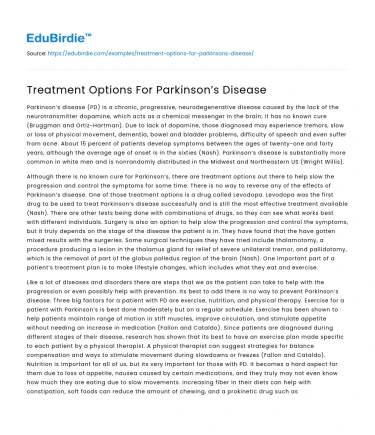Parkinson’s disease (PD) is a chronic, progressive, neurodegenerative disease caused by the lack of the neurotransmitter dopamine, which acts as a chemical messenger in the brain; it has no known cure (Bruggman and Ortiz-Hartman). Due to lack of dopamine, those diagnosed may experience tremors, slow or loss of physical movement, dementia, bowel and bladder problems, difficulty of speech and even suffer from acne. About 15 percent of patients develop symptoms between the ages of twenty-one and forty years, although the average age of onset is in the sixties (Nash). Parkinson’s disease is substantially more common in white men and is nonrandomly distributed in the Midwest and Northeastern US (Wright Willis).
Although there is no known cure for Parkinson’s, there are treatment options out there to help slow the progression and control the symptoms for some time. There is no way to reverse any of the effects of Parkinson’s disease. One of those treatment options is a drug called Levodopa. Levodopa was the first drug to be used to treat Parkinson’s disease successfully and is still the most effective treatment available (Nash). There are other tests being done with combinations of drugs, so they can see what works best with different individuals. Surgery is also an option to help slow the progression and control the symptoms, but it truly depends on the stage of the disease the patient is in. They have found that the have gotten mixed results with the surgeries. Some surgical techniques they have tried include thalamotomy, a procedure producing a lesion in the thalamus gland for relief of severe unilateral tremor, and pallidotomy, which is the removal of part of the globus palledus region of the brain (Nash). One important part of a patient’s treatment plan is to make lifestyle changes, which includes what they eat and exercise.
Save your time!
We can take care of your essay
- Proper editing and formatting
- Free revision, title page, and bibliography
- Flexible prices and money-back guarantee
Like a lot of diseases and disorders there are steps that we as the patient can take to help with the progression or even possibly help with prevention. Its best to add there is no way to prevent Parkinson’s disease. Three big factors for a patient with PD are exercise, nutrition, and physical therapy. Exercise for a patient with Parkinson’s is best done moderately but on a regular schedule. Exercise has been shown to help patients maintain range of motion in stiff muscles, improve circulation, and stimulate appetite without needing an increase in medication (Fallon and Cataldo). Since patients are diagnosed during different stages of their disease, research has shown that its best to have an exercise plan made specific to each patient by a physical therapist. A physical therapist can suggest strategies for balance compensation and ways to stimulate movement during slowdowns or freezes (Fallon and Cataldo). Nutrition is important for all of us, but its very important for those with PD. It becomes a hard aspect for them due to loss of appetite, nausea caused by certain medications, and they truly may not even know how much they are eating due to slow movements. Increasing fiber in their diets can help with constipation, soft foods can reduce the amount of chewing, and a prokinetic drug such as Cisapride can increase the movement of food through the digestive system (Fallon and Cataldo). Although for a healthy individual protein may be super important, patients with PD need to limit how much protein they intake. The drug Levodopa is an amino acid, and is absorbed by the digestive system by the same transporters that pick up other amino acids broken down from proteins in the diet (Fallon and Cataldo). So if the patients are limiting how much protein they ingest, it may help their body better absorb the Levodopa. Currently at the moment research shows that supplements do not have any effect of the disease. No antioxidants have showed promise as a treatment except selegiline, a MAO-B inhibitor (Fallon and Cataldo).
Another factor that is important for patients suffering with any disease or disorder is to seek therapy. Patients with Parkinson’s do have a possibility of developing depression. Approximately one-third of patients will have depression at any one time, whether that be from the disease itself or a reaction from medication (Nash). Seeing a therapist regularly will help patients talk about their symptoms and keep their depression at ease. It may even help them get a care plan in place, that way the patients and their doctors know what has expected if ever the patient is unable to communicate.
Some other facts about Parkinson’s are that Michael J. Fox was diagnosed in 1991. He is the founder of The Michael J. Fox Foundation; they accept donations to help aggressively find a cure for Parkinson’s. The foundation also hopes to improve therapy options for those living with the illness today.
Works Cited
- Bruggman, Amber and Ortiz-Hartman, Kimberly. 'Parkinson Disease: Palliative Care.' Salem Health Community & Family Health Issues, edited by Amber Bruggman and Kimberly Ortiz-Hartman, Salem, 2017. Salem Online, https://online-salempress-com.bc3.idm.oclc.org
- Fallon, L. Fleming, Jr., and Laura Jean Cataldo. 'Parkinson's Disease.' Gale Encyclopedia of Nursing and Allied Health, edited by Gale, 3rd edition, 2013. Credo Reference, https://bc3.idm.oclc.org/login?url=https://search.credoreference.com/content/entry/galegnaah/parkinson_s_disease/0?institutionId=2672. Accessed 04 Feb. 2020.
- Nash, Donald J. 'Parkinson’s disease.' Psychology and Mental Health, edited by Nancy A. Piotrowski, Salem, 2009. Salem Online, https://online-salempress-com.bc3.idm.oclc.org
- Wright Willis, Allison et al. “Geographic and ethnic variation in Parkinson disease: a population-based study of US Medicare beneficiaries.” Neuroepidemiology vol. 34,3 (2010): 143-51. doi:10.1159/000275491






 Stuck on your essay?
Stuck on your essay?

